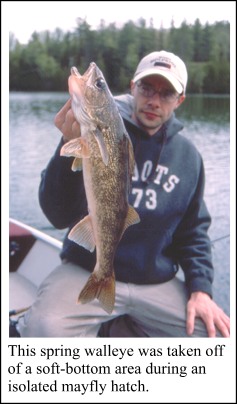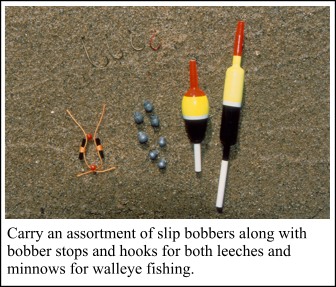Catching Walleye
during a Spring Mayfly Hatch Take a close look at a walleye's mouth and its teeth tell the story - they have evolved to feed on fish. Yet, walleye don't survive on fish alone. Ever the opportunists, these marble-eyed predators will snatch up meals whenever they get the chance, and there are few underwater appetizers as easy for them to eat as mayfly nymphs.
The life cycle of mayflies is egg to nymph, followed by nymph to adult. A mayfly spends the majority of its life as a nymph, also called larva. Classified as benthic (bottom dwelling) invertebrates, nymphs crawl along the bottom, hiding in debris and vegetation while some create burrows. Flats and bays with soft mud or silt bottoms are prime nymph habitat. Some nymphs live in deep water, but most stay shallow to soak up sun which is crucial for their growth. In spring, maturing nymphs become active as they prepare to emerge from the water. Once conditions are right, mature nymphs swim to the surface or crawl on land, shedding their casings and molting into winged adults. As adults their lifespan is relatively short, with their sole purpose to mate before dying. As with any migration in nature, increased activity and concentrated numbers of organisms will attract predators. The mayfly-walleye relationship is no different. "Primarily the time of year when a fish like walleye zeros in on mayfly nymphs is the early to late spring period when the organisms are emerging from the mud in fairly concentrated areas, especially the types that burrow into the substrate," says OMNR's Tom Mosindy of the Lake of the Woods Fisheries Assessment Unit. Given their post-spawn predisposition to binge-feeding, catching walleye targeting mayfly nymphs can be easy - if you know where to look. The first step is finding soft-bottomed flats comprised of mud, sand and silt that hold mayfly nymphs. My sonar displays soft-bottom areas as a thin line as mud or silt absorbs and scatters the sonar's signals. Once you've found some soft-bottom areas, fish those that are close to spawning areas first, as these spots are natural transition zones and resting points for recovering fish. Also consider the light preferences of walleye. Shaded flats or ones containing weeds and wood will hold walleye better than ones in sunlight and void of cover. Small 1/16 or 1/8-ounce jigs in both dark and light colours can be deadly when walleye feed on nymphs during early spring. Try to make jigs mimic a nymph's erratic movements during the retrieve. If casting, slowly crawl or subtly hop it along bottom. If vertical jigging, thump the jig in place to kick up debris. This tactic appeals to a walleye's curiosity and can trigger hits. Walleye often suck-in nymphs and hits can be subtle. Greg Klatt, of ProFISHn't Angling Services ( www.profishntanglingservices.com ) , finds detecting hits from nymph-feeding walleye can be tough. "Stay focused on watching your line for the slightest twitch indicating that a walleye has sucked in your bait. You need to set the hook immediately or the fish will blow the bait back out. I often find that tipping the jig with a small piece of worm will entice more bites and gives you more time to set the hook, as the fish hangs on to the jig a little longer," he says. A rod with a sensitive tip and low-stretch line will also help you detect hits.
During spring feeding binges walleye are not as selective on baits matching-the-hatch as they in the summer. When spring fishing this season pay attention to water surface activity and look for isolated hatches. If near post-spawn staging areas, these spots might serve as feeding zones for recovering walleye. Fish them with jigs or slip bobbers and live bait. In an upcoming article, I'll share strategies on how to catch walleye in the summer during isolated and large-scale mayfly hatches.
|


 Mayfly
nymphs are more than simple snacks for walleye. They're a main component
in walleye diets at certain times of the year. In the spring, gluttonous
post-spawn walleye will cruise soft-bottom areas feeding on nymphs and in
the summer walleye will target emerging nymphs during a hatch. To
effectively catch walleye feeding on nymphs, anglers need to understand
the predator-prey relationship between these two species. This includes
where to locate nymph-eating 'eyes and downsizing lures to imitate these
immature mayfly morsels.
Mayfly
nymphs are more than simple snacks for walleye. They're a main component
in walleye diets at certain times of the year. In the spring, gluttonous
post-spawn walleye will cruise soft-bottom areas feeding on nymphs and in
the summer walleye will target emerging nymphs during a hatch. To
effectively catch walleye feeding on nymphs, anglers need to understand
the predator-prey relationship between these two species. This includes
where to locate nymph-eating 'eyes and downsizing lures to imitate these
immature mayfly morsels. If
fishing slows, a slip bobber and a small jig tipped with a piece of worm
or leech can tease out a few hits. "After you cast out, let the jig and
float settle for a few seconds and then slowly pull or reel in
approximately three to four feet of line, then pause again." Continue this
style of retrieve until you have covered the area.
If
fishing slows, a slip bobber and a small jig tipped with a piece of worm
or leech can tease out a few hits. "After you cast out, let the jig and
float settle for a few seconds and then slowly pull or reel in
approximately three to four feet of line, then pause again." Continue this
style of retrieve until you have covered the area.